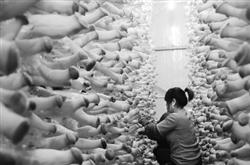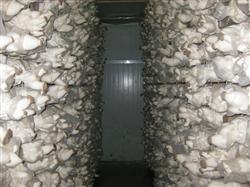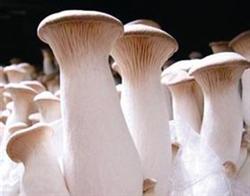Brief introduction of artificial cultivation and Management techniques of Pleurotus eryngii

Pleurotus eryngii Pleurotus eryngii (DC.ex Fr) Quel belongs to the genus Pleurotus ostreatus, fungal phylum, basidiomycetes, Basidiomycetes, Pleurotus ostreatus, Pleurotus ostreatus. Pleurotus ostreatus, also known as Pleurotus ostreatus, gets its name because it mainly occurs on the dead plant (root) of Umbelli ferae. This mushroom has the fragrance of almonds. In Fujian and Taiwan, it is called Pleurotus eryngii, or Pleurotus eryngii for short. Pleurotus eryngii is a kind of large fleshy umbrella fungus with thick meat, crisp and tender texture, delicate taste, delicious taste and fragrant almond flavor. what is more valuable is that it is rich in fungal oligosaccharides, which has the effect of cleaning intestines and stomach, cosmetology and lowering blood pressure and blood lipids. Wild Pleurotus eryngii is mainly distributed in the mountains, grasslands and deserts of many countries in southern Europe, northern Africa and Central Asia. It is also distributed in Sichuan, Qinghai, * * and other areas of China. Its fresh products have a long shelf life under natural conditions (usually about 5 ℃ can be preserved for 1 week. About 3 ℃ can be preserved for about 12 days without deterioration. Suitable for a variety of methods of processing and cooking, not only with vegetables, meat, eggs, fish cooking, but also can be fried separately (fried to the skin is better), stuffing dumplings taste better. So it is a kind of high-grade edible fungus which is very popular with consumers. Now the bag planting method is briefly introduced as follows. First, cultivation sites that can cultivate Pleurotus ostreatus and Lentinus edodes can be used to cultivate Pleurotus eryngii. The general condition of the site is that it can keep warm, moisturize, avoid light, be well ventilated and close to the water source. Such as plastic sheds, waste factories, caves and so on. 2. In the cultivation season, the optimum temperature for Pleurotus eryngii to produce mushrooms is 10: 22 ℃. It takes about 40 to 60 days from bag inoculation to mushroom production. The cultivation season can be arranged according to the local specific temperature. It is more suitable for cultivation in late autumn and early spring. At present, the cultivation methods and varieties are bottle cultivation, bag cultivation (discrete and three-dimensional) and box cultivation. But all must be clinker. The better varieties are Pleurotus eryngii No. 1, No. 2 and Beijing Pleurotus eryngii, whose biological efficiency can reach 50%-160%. Fourth, cultivation raw materials 1. The main raw materials, such as cotton husk, corncob, broken bean straw, bagasse, sawdust, chopped rice straw or wheat straw (one of them) can be used as the main raw materials for the cultivation of Pleurotus eryngii. two。 The auxiliary materials such as fine rice bran, wheat bran, corn meal, gypsum powder, white ash, sugar and potassium dihydrogen phosphate are good auxiliary materials for cultivating Pleurotus eryngii. Fifth, strain production 1. The mother seed uses PDA medium or PDA plus 3G peptone, and the best medium is enriched comprehensive medium, and the mycelium grows sturdily and vigorously. After inoculation, the mother seed grew well when cultured at 22: 26 ℃ for 10 to 13 days. two。 The original cultivated species can use broad-leaved tree sawdust or crushed corncob plus bran medium, such as adding part of cottonseed husk on this basis, the mycelium growth rate can be accelerated. The original cultivated species can also use wheat or corn kernels as culture medium. After inoculation, the original species were cultured under the condition of avoiding light and good ventilation at 22 ~ 26 ℃, and the bottle (bag) could grow after 25 ~ 35 days. 3. Cultivation (1) there are many substrates suitable for the growth and development of Pleurotus eryngii (only 1 case: for reference). Sawdust 35%, cottonseed hull or corncob 40%, wheat bran 18%, corn flour 3%, sugar 1%, calcium carbonate 1%, gypsum powder 1%, potassium dihydrogen phosphate 0.5%, magnesium sulfate 0.3%, urea 0.2%. (2) when mixing the material in the bag, it can be operated according to the proportion of the formula according to the conventional method, and mix evenly and then bag it. Polypropylene or high density polyethylene plastic bags with specifications of (17: 22) cm × (35: 45) cm can be selected and filled with holes in 1~3cm diameter to facilitate the growth and development of hyphae and bind the mouth of the bag. (3) the bacteria bag packed with sterilization and inoculation should be sterilized in time under the pressure of each cm21.5kg for 2 hours or in an atmospheric cooker for 10 to 12 hours, and then inoculated in the inoculation box or sterile room after cooling. After inoculation, it was cultured in shade at 18: 25 ℃, and the bag was full at about 25: 35 days. (4) the management of the growth and development stage of Pleurotus eryngii fruiting body is the key to achieve high yield, stable yield and high quality. After the mycelium grows in the bag, it can be transferred to the management of the mushroom stage. Open the mouth of the bag and roll the plastic bag close to the culture medium, spray water to moisturize, properly reduce the temperature, increase light, and promote mushroom production. At this time, the relative humidity is generally required to be about 80% 95%. After about 15 days, the primordium can be seen. After the primordium differentiates into mushroom buds, under the condition of 8-20 ℃ and the relative humidity of 85%-95%, the mushroom buds will continue to grow and form normal fruiting bodies. Generally speaking, the management of mushroom production period should comprehensively consider the factors such as temperature, humidity, ventilation, light, nutrition and bag opening time, and constantly sum up experience in order to cultivate mushrooms with high quality, high yield, long mushroom production period and good commercial quality. (5) in the vegetative growth stage of pest control, the common fungal diseases are green mold, yellow mold, black mold and Mucor pollution. Due to the growth of miscellaneous bacteria, the growth of normal mycelium is poor. The main causes are high amount of bacteria in raw materials, incomplete disinfection and sterilization, unsuitable pH value, extensive inoculation, poor ventilation in culture environment and high content of miscellaneous bacteria. The prevention and control methods mainly include the selection of fresh, non-impurity and pollution-free raw materials, uniform mixing, suitable pH value, thorough disinfection and sterilization, careful inoculation, suitable temperature and humidity of the culture environment, and good ventilation. In the stage of reproductive growth, the common symptoms of bacterial diseases are dead mushrooms, rotten mushrooms, yellow spots on mushrooms and so on. The causes are the introduction of bacteria, the introduction of tools and water during operation, and the artificial diffusion and spread caused by daily management operation. Prevention and control methods: select bacteria without bacterial pollution, inoculation tools and daily management equipment should be thoroughly disinfected, do not store water for humidification of mushroom house for too long, etc. In addition, insect pests may occur in the whole cultivation process, and the main species are mosquitoes and flies. The cause of occurrence: the introduction of bacteria and the migration of outside. Prevention and control methods: use insect-free, healthy and normal bacteria, reduce the entry of unnecessary personnel, and add screen windows to the ventilation hole of the mushroom room. (6) harvesting and processing should be harvested when the mushroom cover is nearly flat, the color becomes lighter, the edge is slightly involute, and the spores are not ejected. The mushroom harvested in advance has a good flavor and a long shelf life. After the first tide mushroom is harvested, the material surface should be cleaned in time and the contaminated bacteria bags should be removed at the same time. Adjust the temperature, humidity, ventilation and light of the mushroom room, and the second tide mushroom can grow after 10-15 days. After harvest, Pleurotus eryngii can be sold immediately or refrigerated at 2-4 ℃, sliced to dry or dried, or processed into salted products and cans.
- Prev

Industrial cultivation techniques of Pleurotus eryngii
Pleurotus eryngii, also known as Pleurotus ostreatus, is a kind of high-quality large umbrella bacteria in the mountains, grasslands and deserts of southern Europe, northern Africa and Central Asia. The meat is thick, crisp and tender, and has almond flavor, so it is a high-grade edible fungus. The optimum temperature for Pleurotus eryngii was 23-25 ℃, and the temperature for primordium formation was 10-18 ℃.
- Next

New technique of bag planting and covering soil of Pleurotus eryngii
Pleurotus eryngii, also known as Pleurotus ostreatus, is one of the rare edible fungi. Its meat is thick, crisp and tender, milky white in color, delicious in taste and rich in nutrition. It is known as "meat in vegetarian". Using the following indoor and outdoor soil covering cultivation techniques, the biological biodegradability can reach 100%, 120%, and the mushroom body is commercial and not covered with soil.
Related
- Fuxing push coffee new agricultural production and marketing class: lack of small-scale processing plants
- Jujube rice field leisure farm deep ploughing Yilan for five years to create a space for organic food and play
- Nongyu Farm-A trial of organic papaya for brave women with advanced technology
- Four points for attention in the prevention and control of diseases and insect pests of edible fungi
- How to add nutrient solution to Edible Fungi
- Is there any good way to control edible fungus mites?
- Open Inoculation Technology of Edible Fungi
- Is there any clever way to use fertilizer for edible fungus in winter?
- What agents are used to kill the pathogens of edible fungi in the mushroom shed?
- Rapid drying of Edible Fungi

